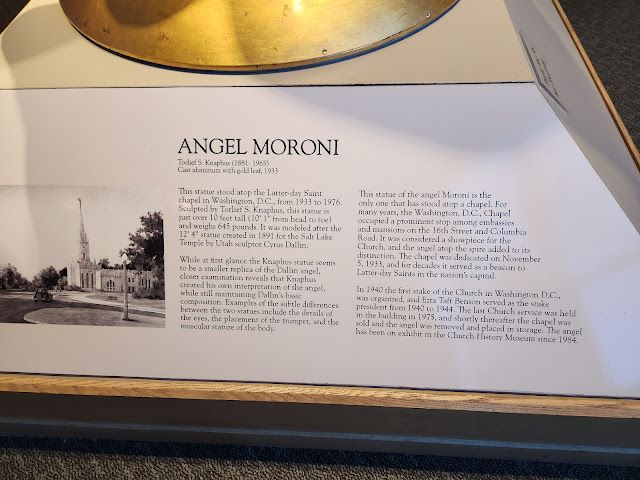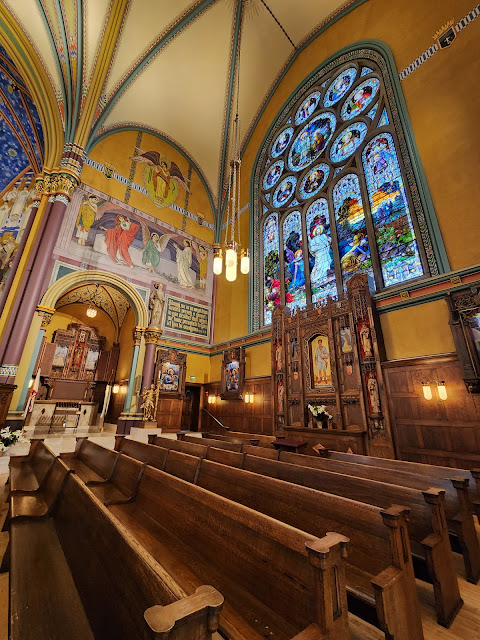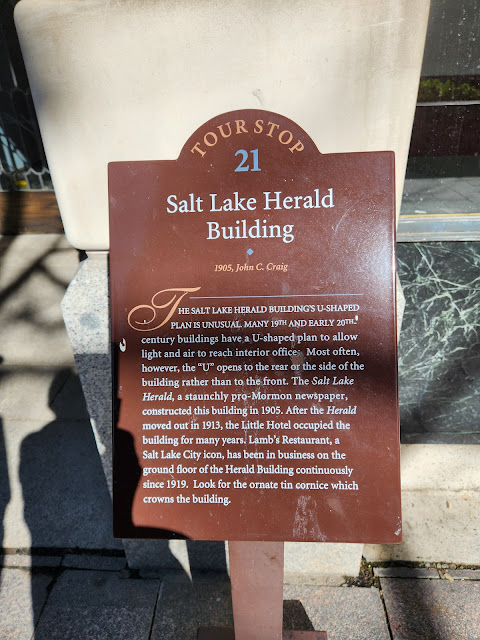April 2 2024 Las Vegas
Click here for:
Mon March 11 Day 1 Toronto to Fort Wayne
Tue Mar 12 Day 2 Fort Wayne to St. Louis
Mar 13 Day 3 St. Louis
Mar 14 Day 4 St. Louis MO to Tulsa OK
Mar 15 Day 5 Tulsa OK to Amarillo TX
Mar 16 Day 6 Amarillo TX to Gallup NM
Mar 17 Day 7 Gallup NM to Las Vegas NV
Mar 18 Day 8 Las Vegas
Mar 19-20 Day 9 - 10 Las Vegas
Mar 21 Day 11 Las Vegas
Mar 21 Day 11 Las Vegas Bellagio
Mar 22 Day 12 Las Vegas
Sat Mar 23 Day 13 Las Vegas Hockey
Mon Tue Mar 25 - 28 Day 15-18 Las Vegas see Weekly Recap Route 66 Coffee
Sat Mar 30 Day 20 Las Vegas see Weekly Recap Brioche
A gorgeous sunny day as we headed out to brunch at 11:15. We went to Eggsburgh right around the corner.
From there we had a loose plan.
Peery Hotel from our room. Squatter's Pub across street.
Plaque on side of hotel.
Inside hotel.
Ready to explore.
Squatter's Pub is the shorter building, chocolate company is taller building.
Often just called the Salt Palace Signs because they’re right in from of the Salt Palace – this art installation called “Point of View” was installed in 2016 and designed to “become the place to have one’s picture taken in Salt Lake City. Like other cities that have iconic artwork or architecture, this new installation beckons people to sit down and be a part of the art.”
There are 150 plus signs that look like standard road signs with words in direct opposition to each other like “Believe, doubt” or “Lost, Found.”
There’s also a “You are here” pointing to a red bench to sit on for photos which we didn't think to do!
Art Gallery
Back at Temple Square - Assembly Hall
The Church History Museum, formerly the Museum of Church History and Art, is the premier museum operated by the Church History Department of the Church of Jesus Christ of Latter-day Saints (LDS Church). It is opposite the west gates of the church's Temple Square.
The museum has collections of art, artifacts, documents, photographs, tools, clothing and furniture from the almost two-century history of the LDS Church. Outside of the curators, administrative, and other staff, a large volunteer workforce of Latter-day Saints from the surrounding communities conduct tours of the museum's exhibits and put on many of the museum programs.
Tabernacle.

A much better view of the Joseph Smith Memorial building (under renovation) today.
The corner of Main Street and South Temple has long been important in Utah history. Prior to construction of the Hotel Utah from 1909 to 1911, the general tithing office of the LDS Church, a bishop's storehouse, and the Deseret News printing plant all were located on the site.
Work on the Second Renaissance Revival style hotel began in June 1909. Two years later, on June 9, 1911, the Hotel Utah opened for business. While the LDS Church was the primary stockholder, many Mormon and non-Mormon community and business leaders also purchased stock in the effort to provide the city with a first-class hotel.
"The largest and finest bar in the West [was built] in the basement of the Hotel" to pay off a $2 million construction loan. The financing was secured by the LDS Church's presiding bishop, Charles W. Nibley, from New York financier Charles Baruch. Originally, the hotel allowed black employees, but no black guests. This policy extended to famous entertainers. Lillian Evanti, Harry Belafonte, Marian Anderson, and Ella Fitzgerald were all denied hotel rooms. Anderson was eventually allowed to stay at the Hotel, on condition that she did not use the elevator and eat her meals in her hotel room.
In 1947, the first non-white professional basketball player, Wataru Misaka, signed his first NBA contract at this hotel. At the time of his signing, according to Misaka, nonwhites were not allowed to stay in this hotel.
The ten-story building has a concrete and steel structure and is covered with white glazed terra cotta and brick. Various additions and remodelings have occurred throughout the years, including a substantial expansion to the north and modifications to the roof-top dining facilities.
It was featured in the 1973 film "Harry in Your Pocket" starring James Coburn.
The building ceased operations as a hotel in August 1987. A major remodeling and adaptive reuse project to accommodate both community and church functions was completed in 1993. Church leader Gordon B. Hinckley chose the name when he observed that there were many monuments to pioneer leader and Utah founder Brigham Young, but none to Joseph Smith.
The building was decorated with the words "SALT LAKE 2002" during the Winter Olympics.
Zion's Co-operative Mercantile Institution (typically referred to as ZCMI) was an American department store chain. It was founded in Salt Lake City, on October 9, 1868, by Brigham Young. For many years it used the slogan, "America's First Department Store."
Even though the Church of Jesus Christ of Latter-day Saints (LDS Church) had been headquartered in Salt Lake City for some twenty years by that time, they were despised by the surrounding community, as Young had disparaged non-Mormon merchants who had engaged in price gouging on necessities, and encouraged boycotting these businesses in 1866. Mormon business owners were routinely charged higher prices by wholesalers who discovered they were dealing with Latter-day Saints.
Partly because of the impending completion of the railroad, and partly to create a more fair business atmosphere, it was Young's idea to encourage Mormon businesses to band together under one roof. By pooling their resources, they were able to make larger orders to sell materials and goods exclusively (at the time) to fellow LDS Church members.
ZCMI was formally organized in 1868 and incorporated for a 25-year renewable contract in 1870. The central component of this was the LDS Church's purchase of the Eagle Emporium, a conglomerate of mercantile companies owned by William Jennings.
ZCMI became a formidable business force, eventually manufacturing its own line of boots and shoes, and a line of work clothes. It also sold everything from housing needs, lumber, nails, and the like, to household needs such as fabric, needles, thread, food preservation products, furniture, and draperies, even some beauty products; nearly everything the pioneers needed to survive and thrive.
It is now a Macy's.
Brigham Young founded Zion’s Savings Bank and Trust Company in 1873 to promote thrift and generate savings for investments in the wake of financial panic. For the first few years the bank operated out of various storefronts on Main Street, but in 1890 it moved to spacious new quarters at this site in the Templeton Building.
The bank successfully weathered the financial difficulties of the Great Depression and in 1957 changed its name to Zions First National Bank when it merged with two other financial institutions. In 1965 the bank moved into its current quarters when the Kennecott Building replaced the Templeton Building. Today, the bank has more than 100 branches in Utah and Idaho and is one of the most influential banking institutions in the West.
The bronze entrance to the Eagle Gate Tower once graced the Federal Reserve Bank building that stood on this corner. A branch of the Federal Reserve Bank first opened in Salt Lake City in 1918, but efforts to construct a building were repeatedly delayed by politics and federal regulations. Utah's Senator Reed Smoot came to the rescue, sponsoring an amendment financing construction.
The Salt Lake architecture firm of Young and Hansen designed the handsome structure of reinforced concrete with granite facing which was completed in 1926, replacing the earlier Gardo House. The building’s stately grandeur symbolized the city’s emerging role as a regional urban center. The Federal Reserve Bank moved to new quarters in 1959, but the building continued to serve as a bank until it was demolished in 1984 to make way for the Eagle Gate Tower.
A close up of the eagle atop a bee hive.
“President Young not only intends it to be used for the education of his own family during the day, but proposes it to be thoroughly devoted to further educational purposes in the evenings, including the teaching of vocal music.
“Mr. David O. Calder will open therein two classes for young persons of both sexes, in order that a competent number may be thoroughly taught this simple and beautiful science, so that a uniform system of teaching may be adopted throughout all the schools of the territory, the produce of the valley will be taken in payment for tuition.”
The Cathedral of the Madeleine is a Roman Catholic church. It was completed in 1909 and is the cathedral, or mother church, of the Diocese of Salt Lake City. It is the only cathedral in the U.S. under the patronage of St. Mary Magdalene.
It is theorized that Bishop Scanlan chose Mary Magdalene as the patron saint of the Diocese of Salt Lake because her feast day is on July 22, two days before Pioneer Day, a celebration commemorating the arrival of the Mormon pioneers in Salt Lake Valley, so that Catholics would have something to celebrate alongside the region's dominant faith.
It is theorized that Bishop Scanlan chose Mary Magdalene as the patron saint of the Diocese of Salt Lake because her feast day is on July 22, two days before Pioneer Day, a celebration commemorating the arrival of the Mormon pioneers in Salt Lake Valley, so that Catholics would have something to celebrate alongside the region's dominant faith.
We stepped into the lobby of Wells Fargo and found these treasures.
Among the historic landmarks in Salt Lake City, few have provided such continuous service as the “Old Zions Bank Clock”. While no official account tells the story, tradition says the clock arrived in the 1870’s in a wagon pulled by oxen. The foundry mark on the base of the clock shows the Robert Wood & Co. in Philadelphia cast it in iron shortly after the end of Civil War.
Originally installed within 30 feet of this site, the clock continues to withstand the test of time. A diversion from City Creek, which ran down Main Street, originally drove a water wheel that operated the clock. Later, the clock kept time with springs and wet cell batteries. By 1912, the original gears had been replaced and the clock was connected to the new electricity system in the bank. In 2007, the clockworks was rewired and restructured. Old paint was sandblasted off the ironwork, and the surface was refinished.
The Old Zions Bank clock is listed on both the state and national historical registries.
The clock is located in front of the Eagle Emporium Building, the location of the first Z.C.M.I.
Built in 1864, The Eagle Emporium Building is the oldest existing commercial building in downtown Salt Lake City. William Jennings, Utah’s first millionaire, constructed the building to house his mercantile business. The Eagle Emporium Building was also the first home of the Zion’s Cooperative Mercantile Institution.
At Brigham Young’s request, Jennings exchanged his emporium’s inventory for stock in the new ZCMI and leased this building to the cooperative in 1868.


















































































Salt Lake City is amazing. Fantastic photos. As if we were there and walking with you. Thank you.
ReplyDeleteFreedom of Religion sounds good. As exploring :-)
ReplyDeleteChocolate... Brewery... I´d chose the latter.
I like the red bench!
Plural marriage. Tough one. As the info on the hotel.
Impressive church and I like the library and wow on that mural.
Your last words really made me laugh :-)
Thank you for the tour!